4 Benefits of Resistance Band Training for Figure Skaters
by Stephanie Siclari
Figure skating requires great strength, balance, mobility and flexibility. Many skaters will spend several hours weekly working off the ice to improve in such areas. One effective way of building power, strength, mobility and flexibility is by executing certain off-ice exercises with resistance bands.
Resistance band training can help the skater gain the strength needed for higher jumps and safer jump landings, improve posture and overall balance, and increase height on spirals.
According to the National Academy of Sports Medicine (NASM), “Bands can help build muscular endurance and explosiveness, balance and coordination, stability, flexibility, mobility, and even increase muscle size and strength. One meta-analysis revealed that when testing either band against free weights and machines on increases in muscular strength for both the lower and upper body, no differences were found between methods. Indicating that bands can provide just as many gains in strength as free weights.”
Let’s take a more in-depth look at the benefits of resistance training:
- Builds strength
Resistance band training is an excellent way to build strength in your muscles, especially in your legs and core. As a figure skater, you need strong legs to perform jumps, spins and footwork. These elastic bands allow you to target specific muscle groups and provide resistance to your movements, making them more challenging and effective.
Using resistance bands when targeting the hips and gluteus medius muscles is a great way to effectively build strength and mobility throughout this region. The gluteus medius is responsible for controlling the alignment of the hip and lower extremities, which is critical for figure skaters.
- Improves flexibility
Flexibility is essential for figure skating, as it helps you achieve the proper positions and movements required for jumps and spins as well as elements in choreography. Resistance band training can help improve your flexibility by stretching your muscles and increasing your range of motion. By incorporating resistance bands into your stretching routine, you can target specific muscle groups and increase your flexibility over time.
- Enhances balance and stability
Figure skating requires excellent balance and stability, especially during jumps and spins. Additionally, ice dance and synchronized skating require a great deal of balance and stability as the skater moves through quick turns and edges while skating in close proximity to another. Resistance training can help improve your balance and stability by challenging your body to maintain proper form while performing exercises. By using resistance bands, you can train your body to maintain balance and stability during movements, which will translate to better performance on the ice.
Using a resistance band when working jumps off the ice can help the skater have better form in the arms and legs when landing jumps. Working jump checkouts with a band on the skater’s arm can increase tension in the upper body and help the skater properly align their upper body in proportion to their lower extremities and help with over-rotation of the shoulder on the landing. Additionally, practicing the landing checkout with a band on the leg helps with strength and control of the skating and free leg, allowing for better alignment, balance and injury prevention. Holding the landing position simultaneously mimics the stroking position, so these exercises are twofold.
- Prevents injuries
Resistance training can also help prevent injuries by strengthening your muscles and improving your flexibility. Stronger muscles are less likely to become injured, and increased flexibility can prevent strains and sprains. Incorporating resistance band training into your off-ice workout can reduce your risk of injury and keep you on the ice longer. Working on building strength, especially through the lower extremities, can help keep the hips, knees and ankles in proper alignment, which reduces the risk of injury on the ice.
Here are several exercises you can try with a resistance band:
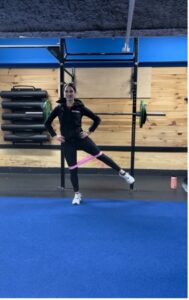
- Standing Side Hip Extensions
Place a resistance band above your knees. Stand on one leg and lift the free leg to the side and return back to a neutral position. Repeat on both legs.
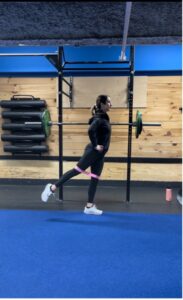
- Standing Back Hip Extensions
Place a resistance band above your knees. Stand on one leg and move the free leg backward and return to a neutral position. Repeat on both legs.
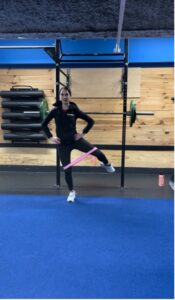
- Clam Shell
Place a resistance band above your knees. Stand on one leg, slightly bend standing knee and bend free leg. Move free leg by opening and closing the knee. Repeat on both legs.
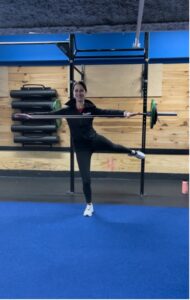
- Landing Checkouts (Arms)
Place a resistance band in your hands. Pull arms and legs into the jump air position and open arms and legs into landing checkout position. Feel the tension in the arms with the resistance of the band.
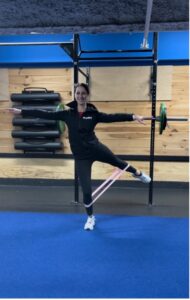
- Landing Checkouts (Legs)
Place a resistance band above your ankles. Pull arms and legs into the jump air position and open arms and legs into landing checkout position. Feel the tension in the legs with the resistance of the band.
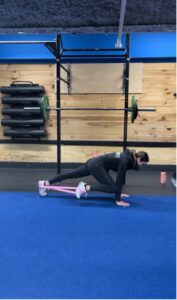
- Mountain Climber
Place band around feet and assume a plank position. Bring right knee to right elbow and return to plank position. Bring left knee to left elbow and return back to plank position.
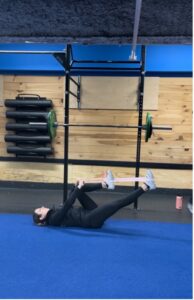
- Hip Flexor Extensions
Place band around feet. Lay on back in a reverse tabletop position. Hold onto band with hands. Gently extend right leg forward and return to neutral (reverse tabletop) position. Gently extend left leg forward and return to neutral position.
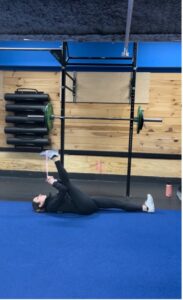
- Hamstring Stretch
Lay on back with legs facing forward. Place band around right foot and lift the right leg straight into the air. Gently pull on the band to stretch the right leg closer to the face. Be sure not to pull too hard but, rather, on the exhale release deeper into the stretch.

Stephanie Siclari has been providing figure skating and power hockey skating instruction for all ages and levels for 20 years. She has worked with skaters from across the globe, who have competed at national and international competitions as well as the U.S. Figure Skating World Synchronized Skating Championships. She is a former senior ladies competitor and two-time U.S. Synchronized Skating champion and Team USA member (Miami University, Ohio, collegiate and senior teams). She is the creator of SKATERFIT, an off- and on-ice training program designed to help skaters build confidence and physical and mental strength while providing a fun platform to achieve their goals. For more information, please visit coachstephaniesiclari.com, where you can also purchase resistance bands. You can visit Stephanie’s YouTube channel for additional exercises.

Established in 1959, the Ice Sports Industry (ISI) — creator of America’s first learn-to-skate curriculum — is an international trade association encompassing all aspects of the ice sports industry. Our goal is to promote ice skating as a participant sport and recreational activity for everyone — all ages and abilities.

 MY COACH ROCKS
MY COACH ROCKS TEAMS IN SYNC
TEAMS IN SYNC EXPRESS YOURSELF
EXPRESS YOURSELF FOCUS ON ARCHIVES
FOCUS ON ARCHIVES COMPETITORS’ CORNER
COMPETITORS’ CORNER NEWS & NOTES
NEWS & NOTES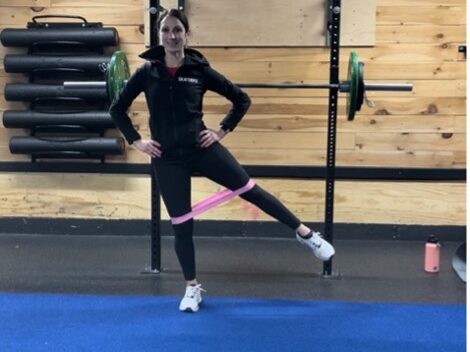







Thank you